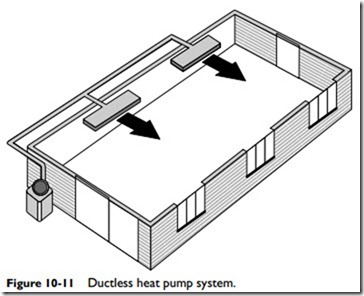Other Types of Heat Pumps
Heat pumps and heat pump systems may also be defined by how the compressor is driven, whether the heat pump is a dual-fuel unit, and other factors.
Gas-Fired Heat Pumps
A gas-fired heat pump is driven by a small natural gas or propane engine which, in turn, drives the compressor. One advantage of a gas-fired heat pump is that the waste heat produced by the engine can be used to supplement the heat output of the heat pump and also to heat the domestic hot water.
Gas-fired heat pumps are available for both residential and commercial applications. They are about as efficient as an air-source heat pump, but they are not widely available and their use is cost-effective only in areas where natural gas or propane cost less than electricity.
Dual-Fuel Heat Pump System
A dual-fuel heat pump system combines an air-source heat pump with a gas furnace in the same heating and cooling system. Instead of using electric resistance heaters, this system uses a gas furnace to back up the heat pump when outdoor temperatures become excessively cold. A conventional gas furnace provides more heat while consuming less energy than electric resistance heating. As a result, a dual-fuel system provides year-round comfort with reduced energy use.
The dual-fuel heat pump system operates just like a typical air- source heat pump under ordinary conditions. In the winter, the air- source heat pump extracts the heat from the outside air, compresses it, and transfers it to an inside coil and blower located inside the house. In the summer, the cycle is reversed. The heat is extracted from the indoor air and sent to the outdoor coil where it is released to the atmosphere. The gas furnace operates as a backup heater to the heat pump only when the outdoor temperature drops below a preset temperature setting.
Dual-Source Heat Pumps
A dual-source heat pump combines a geothermal heat pump and an air-source heat pump in the same unit. This results in a heat pump almost as efficient as the geothermal heat pump but with the advan- tage of being much less expensive to install.
Instead of using only one outdoor heat source and heat sink (that is, air or ground), the dual-source heat pump uses both air and ground sources for the condensing process in the cooling mode and the evap- orating process in the heating mode. In the cooling mode, the liquid refrigerant discharging from an air-source condenser is subcooled by using a ground-source-cooled fluid. This fluid is then reused after the subcooler to desuperheat, that is, to remove some of the superheat from the hot gas before it goes into the air-source condenser.
The ground loop requirements are much smaller than for a con- ventional ground-source system, which reduces the initial installa- tion cost. Some dual-source heat pump systems are installed with dual compressors to provide additional heat during the coldest out- door temperatures.
Dual-source heat pumps are of limited availability in the United States. As a result, it is difficult to find contractors with the neces- sary experience to install and service them.
Ductless Heat Pumps
A ductless heat pump (also sometimes called a mini-split-system heat pump) is essentially a heat pump without distribution ducts (see Figure 10-11). The ductless heat pump is used primarily for cooling, although in some applications both heating and cooling are possible.
A typical ductless heat pump system consists of one outdoor unit (and compressor) connected by refrigerant lines to more than one small indoor unit. Refrigerant is piped from the outdoor unit through small-diameter insulated refrigerant lines directly to individual rooms or zones. Cooled air is blown into the room by fans located in the individual evaporator units. It is called a mini split system because of the multiple small (“mini”) indoor units.
The indoor units are about 6 to 8 in deep and are commonly mounted flush to the inside surface of an exterior wall. They can also be mounted on a ceiling or inside a dropped ceiling. Wiring, refrigerant lines, control cables, and the condensate drain all pass through a small 3-in-diameter hole in the wall or ceiling.
